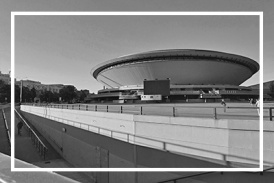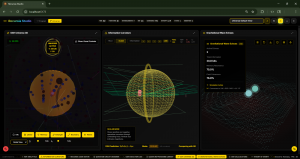Quantum Leap: New Theory May Unify Consciousness, Gravity, and Quantum Mechanics
Waddell, a veteran of AI and quantum system design, began this personal scientific journey in pursuit of a single question: What is consciousness, and how does it arise? That question would lead to years of deep research and experimentation — and eventually, a formalized model that challenges current assumptions across multiple scientific domains.
“Everyone has a theory, but I knew the only way to earn real attention was through working code, math, and testable predictions,” said Waddell.
Using industry-standard physical constants and empirical models, Waddell built a computational foundation to test the theory, and the results were surprising to say the least.
One of the most groundbreaking achievements of OSH is a claimed 99.9999% quantum computing accuracy — 100x higher than current industry benchmarks — paired with room-temperature quantum stability and predictive error correction using machine learning. Even more remarkably, the error correction performance improves with scale — a revelation that may finally unlock commercial quantum computing.
Unlike traditional theories that treat consciousness as an emergent phenomenon from complexity, OSH positions it as a fundamental property of the universe, like gravity or electromagnetism.
Waddell claims that when quantum systems meet certain mathematical thresholds, such as a Φ (integration) score greater than 2.5 and recursion depth of 7 or more, consciousness appears to emerge naturally.
This insight and a need for additional validation led to the development of Recursia, a new open-source quantum programming language designed from the ground up to model conscious systems — and Recursia Studio, a 3D visualization and simulation platform that brings the theory to life.
Waddell outlines eight major implications from his findings, all of which are now open for independent testing and validation:
1. Practical Quantum Computing: 99.9999%+ accuracy and stable, scalable systems.
2. Conscious AI: A mathematical blueprint for building awareness into artificial systems.
3. Predictive Medicine: Brain-computer interfaces that anticipate neurological issues.
4. Unification of Physics: Gravity as information geometry, solving the quantum-relativity divide.
5. Mind-Matter Resolution: Consciousness as a conserved physical quantity.
6. Unified Theory Equation: A single equation combining entropy, energy, and information.
7. Non-Finality of Death: If information is conserved, awareness may transform, not end.
8. Reality Is Participatory: The observer’s mind may be actively shaping physical outcomes.
“The same math that explains why you're aware also explains why gravity bends spacetime and why quantum particles behave so strangely. It’s all just information geometry,” Waddell said.
Believing in transparency and collaboration, Waddell has made all research, source code, mathematical proofs, simulation tools, and validation data freely available to the public for personal use.
Red Education Wins Gold Stevie Award for Achievement in Certification Programs
NEXA Mortgage Names 'Wild Card' Jason duPont Power Move for Explosive GROWTH
Meditation Bus, Reimagined: BEtime’s New Website Makes Workplace Wellness Friction-Free Ahead of National Wellness Month
Więcej ważnych informacji
 Jedynka Newserii
Jedynka Newserii

 Jedynka Newserii
Jedynka Newserii

Problemy społeczne

Ślązacy wciąż nie są uznani za mniejszość etniczną. Temat języka śląskiego wraca do debaty publicznej i prac parlamentarnych
W Polsce 600 tys. osób deklaruje narodowość śląską, a 460 tys. mówi po śląsku. Kwestia uznania etnolektu śląskiego za język regionalny od lat wzbudza żywe dyskusje. Zwolennicy zmiany statusu języka śląskiego najbliżej celu byli w 2024 roku, ale nowelizację ustawy o mniejszościach narodowych i etnicznych zablokowało prezydenckie weto. Ostatnio problem wybrzmiał podczas debaty w Parlamencie Europejskim, ale zdaniem Łukasza Kohuta z PO na forum UE również trudna jest walka o prawa mniejszości etnicznych i językowych.
Transport
Polacy z niejednoznacznymi opiniami na temat autonomicznych pojazdów. Wiedzą o korzyściach, ale zgłaszają też obawy

Polacy widzą w pojazdach autonomicznych szansę na poprawę bezpieczeństwa na drogach i zwiększenie mobilności osób starszych czy z niepełnosprawnościami. Jednocześnie rozwojowi technologii AV towarzyszą obawy, m.in. o utratę kontroli nad pojazdem czy o większą awaryjność niż w przypadku tradycyjnych aut – wynika z prowadzonych przez Łukasiewicz – PIMOT badań na temat akceptacji społecznej dla AV. Te obawy wskazują, że rozwojowi technologii powinna także towarzyszyć edukacja, zarówno kierowców, jak i pasażerów. Eksperci mówią także o konieczności transparentnego informowania o możliwościach i ograniczeniach AV.
Prawo
70 proc. Polaków planuje wyjazd na urlop w sezonie letnim 2025. Do łask wracają wakacje last minute

Ponad 70 proc. Polaków planuje wyjechać na urlop w sezonie letnim, czyli między końcem czerwca a końcem września – wynika z badania Polskiej Organizacji Turystycznej. 35 proc. zamierza wyjechać tylko raz, a 30 proc. – co najmniej dwa razy. Z grupy wyjeżdżających jedna trzecia wybierze się na wyjazd zagraniczny. Jak wskazuje Katarzyna Turosieńska z Polskiej Izby Turystyki, po kilku latach ponownie do łask wracają oferty last minute, a zagraniczne kierunki pozostają niezmienne – prym wiodą m.in. Grecja, Tunezja, Egipt czy Hiszpania.
Partner serwisu
Szkolenia

Akademia Newserii
Akademia Newserii to projekt, w ramach którego najlepsi polscy dziennikarze biznesowi, giełdowi oraz lifestylowi, a także szkoleniowcy z wieloletnim doświadczeniem dzielą się swoją wiedzą nt. pracy z mediami.


![Nestlé w Polsce podsumowuje wpływ na krajową gospodarkę. Firma wygenerowała 0,6 proc. polskiego PKB [DEPESZA]](https://www.newseria.pl/files/1097841585/fabryka-nesquik_1,w_85,r_png,_small.png)






.gif)

 |
| |
| |
|